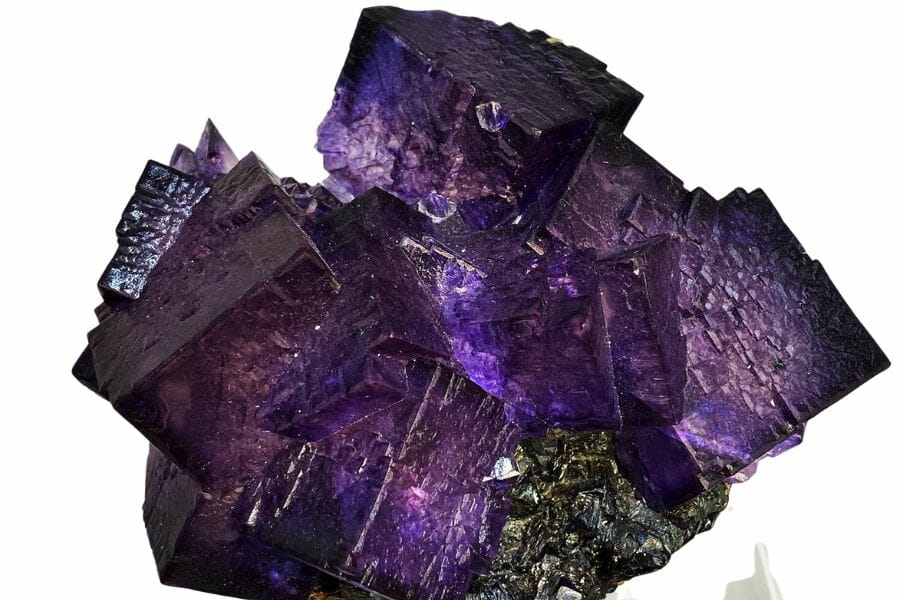Finding rocks, minerals, and gems can be one of the most fun and rewarding activities there is. You have the thrill of the hunt, the fun of the outdoors, and the possibility of finding beautiful treasures for your collection.
The best places for rockhounding near you can be tricky to find though, if you don’t have a guide. Fortunately, the Rock Chasing community has a wealth of knowledge and maps that can help you find all of the best spots.
From rocks and crystals to gems and minerals there are so many great things you can find all over the world. We’re going to show you our favorite rocking hunting places in your area, what to look for, and what you need to do in order to prepare ahead of time.
Many of the top spots for rockhounds are free but some do require a fee to dig there. We try to give you a good mix so that anyone with any budget can find success.
Take a look at the map below and start finding some beautiful specimens for your collection!
Rockhounding Map and Local Guides
*Click On Each State To See An In-Depth Guide*
We’ve put together full local guides for each state in the US. Each guide has dozens of locations around the state that have been great places to find various rocks and minerals.
It doesn’t matter where you live, there are great places for rockhounding near you. You might need to do a bit of hiking to get there though!
If you’re on your phone clicking on the states above can be a bit tricky so we will also list out the individual guides below for you to select. Read through them and let us know if we missed any great locations that should be included!
Local rockhound guides for each state
We will be adding more guides as time goes on and we find more locations for you to try. We’ll also be regularly updating the current guides.
Additional local guides
We have also put together a number of other local guides for finding specific types of rocks, minerals, gems, and crystals. Check out the following guides if you’re looking for something specific:
- Local amethyst mining guides
- Local crystal mining guides
- Local gem mining guides
- Local geode hunting guides
- Local obsidian hunting guides
- Local petrified wood hunting guides
Essential Rockhounding Equipment
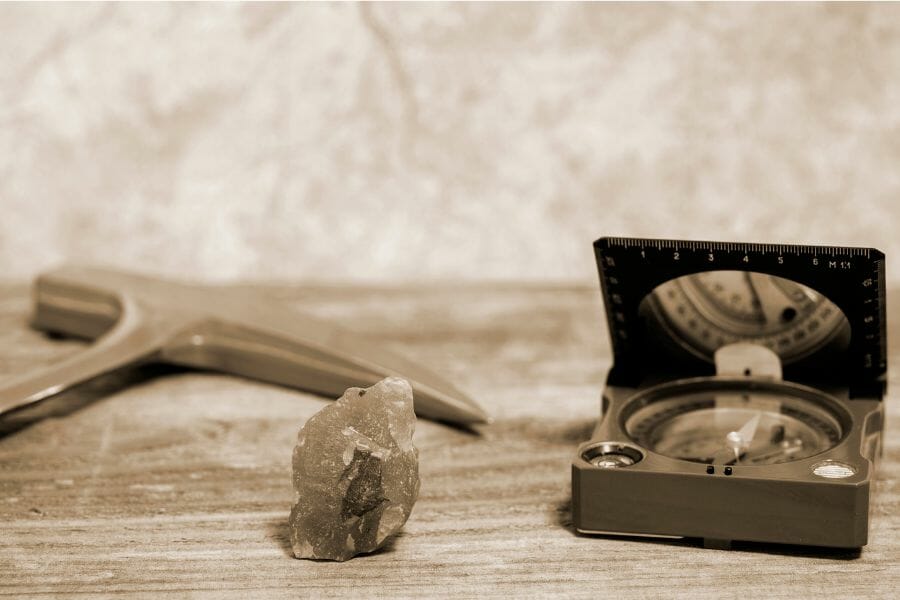
Now that you’ve checked out our local guides above you need to make sure that you’re properly equipped for your expedition. Having the right tools is essential to getting the best results and rockhounding can be a pretty inexpensive hobby as long as you have the essentials.
We’ve already put together a complete guide of the rockhounding tools we like best that you can check out but we’ll give you an overview here as well. Check out the full guide above for all of our reasoning and recommendations.
One quick note, as an Amazon Associate I earn from qualifying purchases but we try very hard to only recommend gear we would use ourselves and often recommend brands you can’t find on Amazon.
These are what we consider to be the essential tools for any rockhound and our favorites.
Must-have tools
- Rock hammer – Estwing 22 oz Geological Hammer
- Chisels – Kendo 3-piece Chisel Set
- Hand sledgehammer – Estwing 3-Pound Sledge
- Compact shovel – Koleiya 28-inch shovel
- Rock screen pans – Wazakura Soil Sieve Set
- Hand lens – JARLINK Jewelers Magnifier
- Cleaning brush – Atlasta Parts Cleaning Brush
- Crowbar – Edward Wrecking Bar
- Durable bag – Husky Tool Bag
- Headlamp – SLONIK Rechargeable Headlamp
- A good bucket
- Water spray bottle
Important safety equipment
- Safety helmet – Malta Dynamics Hard Hat
- Safety glasses – DEWALT Safety Goggles
- Rugged boots
- Protective gloves
At first glance that looks like a lot of equipment but there isn’t any one item that is particularly expensive. The entire kit should be able to fit into the Husky tool bag that we recommend as well.
How to get the best results rockhounding near you
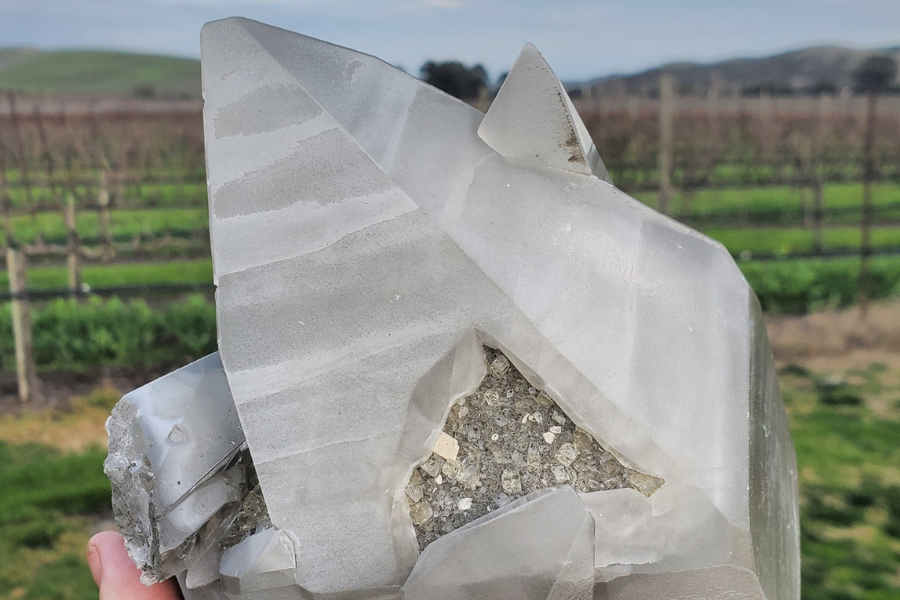
Once you have an idea of where to go and the tools necessary to do that job we have a few more tips for you that have really helped us out.
Plan your dig and dig your plan
Planning is crucial to rockhounding success as it significantly increases the likelihood of a fruitful and safe expedition. Without proper planning, it’s very easy to waste a ton of time in unproductive areas, miss potential discoveries, and even face safety hazards.
Researching your location beforehand allows you to understand the geological history and types of rocks or minerals you might find there. If you know what you should keep an eye out for you’re going to be much less likely to miss it!
Knowledge of the terrain helps anticipate the necessary equipment and physical preparedness required and checking weather forecasts ensures you avoid harsh conditions that could make your trip dangerous or unenjoyable.
We’ve heard so many stories (and fallen victim ourselves) of under-planned expeditions that ran into tons of problems. This quickly becomes a nightmare of frustration and ultimately leaves you empty-handed.
Always know the law and restrictions
Every place that you explore is going to have different laws and restrictions. Every jurisdiction has specific rules about where and what you can collect and the penalties for violating these can be expensive!
Some areas, like national parks, archaeological sites, or private lands, are often off-limits without express permission. Violating these rules can lead to fines, confiscation of collected specimens, or even legal action.
By following these laws and regulations, rockhounds contribute to the conservation of natural and cultural resources for future generations. Moreover, knowing the rules often leads to better relationships with landowners, government agencies, and other rockhounds, potentially opening more areas for exploration.
Study up on identification
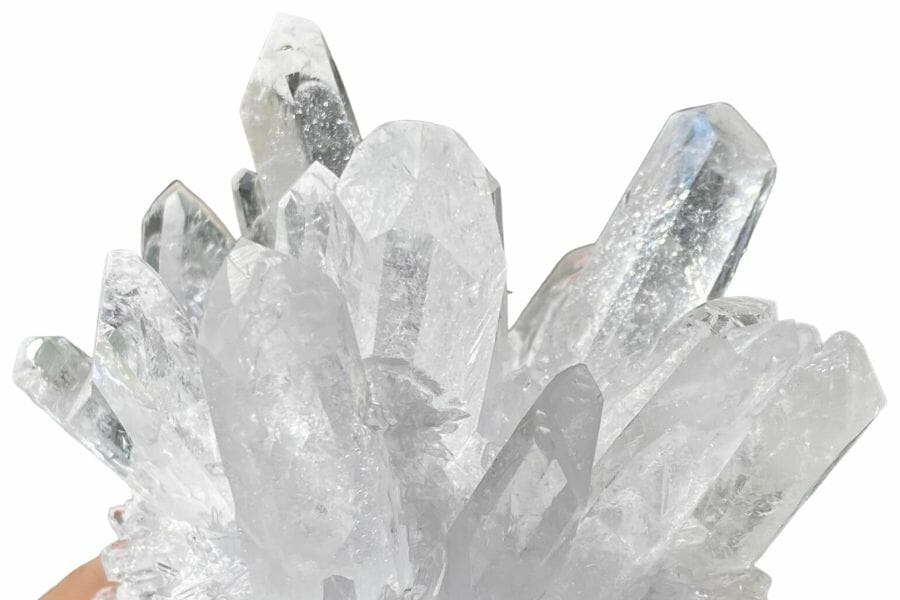
Quartz crystal found and available for sale by Crystaland
You wouldn’t believe the number of times we’ve seen incredible finds pulled out of the discarded piles of other rockhounds. Once you’ve been searching for hours it can be very easy to overlook something that seems benign but is actually a beautiful crystal or gem.
The easiest way to avoid this problem is by spending some time understanding the area you are in and training yourself to identify on sight the rocks and minerals you’re most interested in finding.
The books we recommend below are also really good for this:
- A Field Guide to Rocks and Minerals (Peterson Field Guides) by Pough
- Collecting Rocks, Gems and Minerals: Identification, Values and Lapidary Uses by Polk
- National Audubon Society Field Guide to Rocks and Minerals: North America
- National Geographic Pocket Guide to Rocks and Minerals of North America by Garlick
You don’t want to just be able to identify what things look like when they are cut and cleaned, you also need to be able to identify the surrounding environment it typically shows up in and how it looks when embedded in the rock or ground. It’s very easy to overlook something that isn’t bright and shiny!
There are also some great free resources from the Mineral Society of America.
Go after raining
It isn’t easy to time it right, but if you can plan a trek immediately after a big rain storm you can often make some great finds right on the ground. Big rains will often clear away a fair amount of surface dirt and dust making it much easier to spot different rocks and gems just by walking around.
This has been especially useful for us when looking for arrowheads but it also works really well for rocks and minerals. If you’re not looking for a particularly intense expedition you can just do some hiking in the right spots after a good rain. It’s a nice relaxing way to do a bit of rockhounding.
Patience
Patience is the cornerstone of rockhounding success. Unlike many hobbies, rockhounding doesn’t offer instant gratification but requires time, dedication, and a considerable amount of waiting.
The quest for the perfect rock or mineral often involves hours of meticulous searching, sometimes without finding anything of note. However, with patience, rockhounds develop a keen eye for details, noticing subtle features that others might overlook.
Patience also breeds persistence, the determination to continue searching despite initial setbacks. It’s the patient rockhound who, undeterred by empty-handed outings, keeps returning to the field and eventually unearths the incredible find that all of us get jealous about!
It also allows you to appreciate the journey itself — the serenity of nature, the anticipation of discovery, and the joy of learning. It’s the bridge between a casual interest in rocks and the rewarding pursuit of rockhounding.
How to find more rock-hunting locations in your area
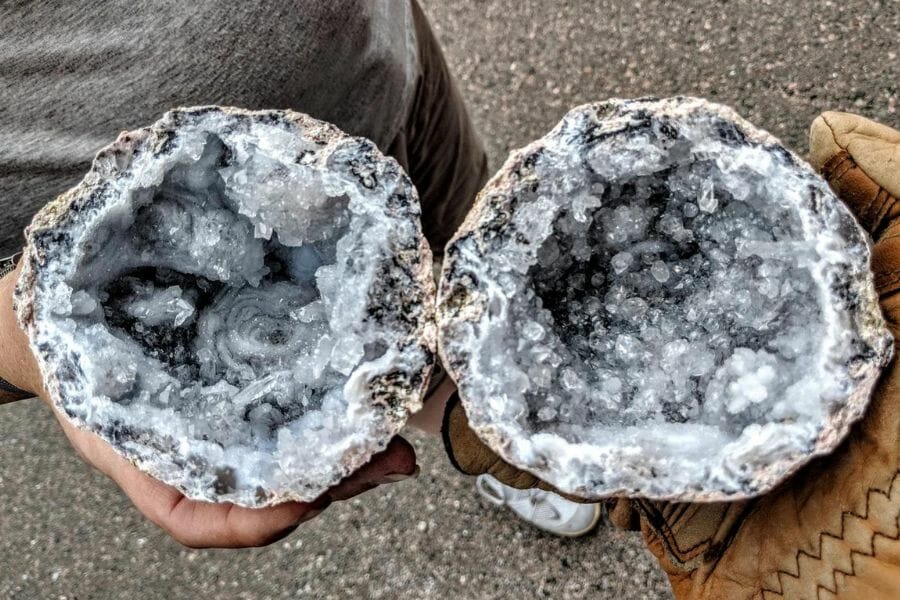
Geode found and for sale by The Geode Guys
While we have over 3,000 rockhounding recommendations in our various guides we know that we are only scratching the surface of what’s out there. There are many ways to find new dig sites but we wanted to share some that have been most effective for us.
Here are some of our favorite ways to find more rock-hunting spots in your area:
Rockhounding books
There are a number of books out there that have been very helpful in our quest to find beautiful rocks and minerals. There are a number of books that help with identification and a smaller number that actually provide useful guidance on locations.
Often when you are out trekking around you won’t have sufficient mobile service to do any kind of meaningful research. It really pays to have at least one good guide that can help you with identification and location.
Our favorite rock identification books (in order)
- A Field Guide to Rocks and Minerals (Peterson Field Guides) by Pough
- Collecting Rocks, Gems and Minerals: Identification, Values and Lapidary Uses by Polk
- National Audubon Society Field Guide to Rocks and Minerals: North America
- National Geographic Pocket Guide to Rocks and Minerals of North America by Garlick
Our favorite rockhounding location books (in order)
It’s much more difficult to find good books that provide rockhounding locations but there are a few that are pretty good:
- Regional Treasure Hunter’s Gem & Mineral Guides by Kathy Rygle (make sure you buy the one for your region)
- Earth’s Treasures by Eckert (make sure you buy the one for your region)
- Falcon Rockhounding Guides (make sure you get the one for your state)
Mines and quarries
Mines and quarries can be unuqually good sites for rockhounds and often prove access to geological layers and mineral deposits that are otherwise impossible to get to. These sites tend to concentrate certain types of rocks and minerals, making the search more focused and potentially rewarding.
There are many rocks and minerals that are nearly impossible to get to outside of mines and mine dumps.
The regular excavation and blasting activities in mines and quarries exposes new material that you would never be able to get to on your own. It’s crucial to obtain necessary permissions before venturing into these sites, as they are often privately owned and can be hazardous.
Some quarries and mines offer guided tours or have designated public collecting areas, providing safe and legal access for rockhounds. Aside from the potential finds, these sites are also educational, offering insights into industrial processes, geological structures, and mineral formations.
Road cuts and construction sites
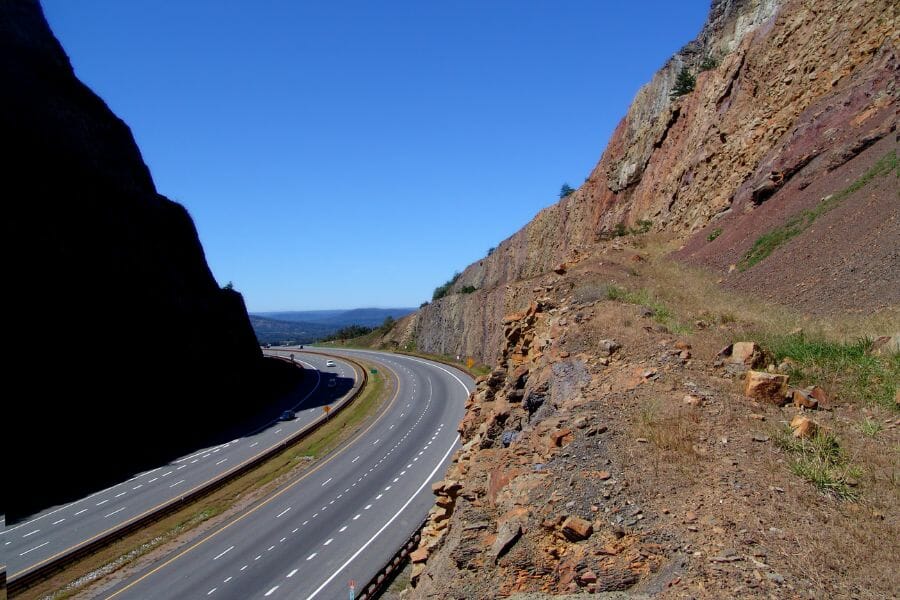
Road cuts and construction sites are often overlooked goldmines (figuratively and literally) for rockhounds. The process of road construction or building excavation often involves cutting through multiple geological layers in the ground, exposing a cross-section of the local geology that may not be visible elsewhere.
These sites can reveal a variety of rocks, minerals, and sometimes even fossils. Since this material is freshly exposed, it’s less likely to be weathered or eroded, allowing for clearer identification.
Construction sites, especially those involving deep excavations like basements or foundations, can also uncover interesting geological treasures but It’s important to remember that these sites can be dangerous, and it’s usually illegal to collect without permission.
Always ensure you have the necessary permissions and take precautions to ensure your safety.
Beaches
Beaches offer a really great range of interesting rocks, minerals, and fossils to collect. They often serve as natural collectors where rocks, minerals, and fossils are washed ashore from underwater deposits or nearby cliffs.
The constant churning of the sea sorts and reveals new material, constantly refreshing the potential finds. Beachcombing after a storm can be particularly fun, as the rough seas can dislodge and wash up lots of interesting stuff.
Some beaches are known for specific finds, such as agates, sea glass, or even amber. It’s important to note that certain beaches have restrictions on what can be collected, so always check local regulations. It’s also a lot of fun just to spend the day on a beach!
Rivers and streams
Rivers and stream are constantly moving rocks and minerals around and exposing new finds. The flowing water moves material from higher elevations and deposits it along the riverbed or downstream areas.
Over time, this process can concentrate a diverse array of geological specimens in one area making it much easier to find them. The action of the water can wear away softer rock, revealing harder, often more valuable material such as agates or even gold.
When rockhounding in rivers and streams, pay particular attention to areas where the water slows down, like inside bends or behind large rocks, as these are places where heavier rocks and minerals are likely to settle.
Finding other rockhounds
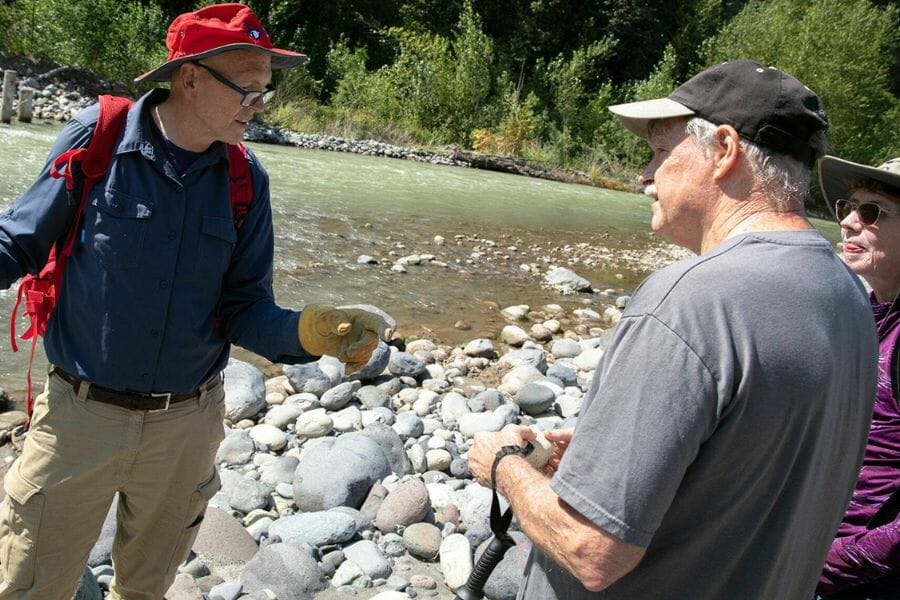
Rockhounding can be a very community driven hobby that has a lot of great people in it. The easiest way to find about great local spots is often to make some new friends who are familiar with the area.
Here are some of the ways we’ve met other rockhounds:
Join your local rockhounding club
Rockhounding clubs are an incredible resource and you can find them all over the country. These are groups of fellow enthusiasts that provide a platform where members can exchange tips, experiences, and details about fruitful locations.
More experienced members, familiar with the local geology, can guide novices towards promising areas that they might not have discovered on their own. Clubs also often organize group excursions to sites that may be inaccessible to individuals, either due to terrain difficulty or permissions required which not only provide an opportunity to explore new locations but also to learn hands-on from seasoned rockhounds.
Rockhounding clubs also often maintain relationships with landowners and local authorities, making it easier to navigate legal requirements. We provide a list of many local clubs in our guides but it might be easier just to search online or on Facebook for clubs in your town.
Contact local universities
Local universities, especially those with geology or earth science departments, can be incredible resources for rockhounds. Professors, researchers, and students in these departments often possess a deep understanding of the regional geology and can provide suggestions for areas where specific types of rocks or minerals are likely to be found.
Universities may also have collections or displays of local geological specimens that can serve as a reference for what to look for. Universities also often conduct fieldwork and research trips, and while these may not be open to the public, the published findings can hint at promising locations for rockhounding.
Some schools even offer short courses or public lectures on geology that can really help out your rock identification skills and geological knowledge.
Visit local gem and rock shops
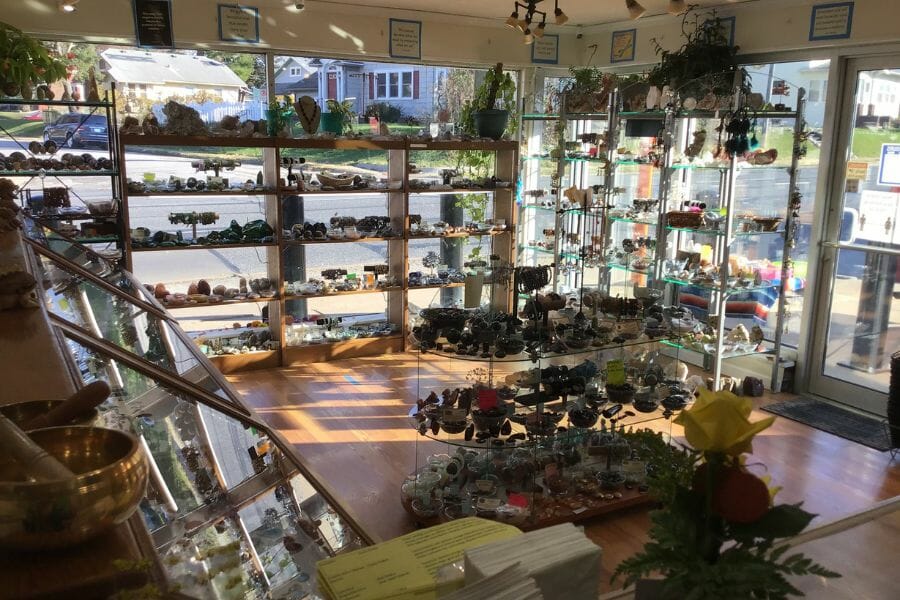
Little Rock and Gem Shop of Davenport, IA
The gem and rock shops in your area are often important hubs of information for rockhounds. The owners and staff of these shops are typically rockhounds themselves and are often willing to share their knowledge about the local geology and potential rockhounding locations.
These are such good sources of info that we have included several suggestions in most of our state guides above.
These shops often source their specimens from local areas, and understanding where and how they acquire their stock can provide valuable insights into great new sites for you to explore.
The specimens for sale can serve as a visual guide to what you might find locally and how to identify them. Some shops also offer workshops or classes on rock and mineral identification, which can further enhance your skills.
These shops are likely to be connected with a broader community of local rockhounds, geologists, and miners, offering further networking opportunities for you to meet like-minded folks.
Gem and mineral shows
Rock, gem, and mineral shows, like the gigantic Tucson Gem and Mineral show, are often attended by a diverse array of rockhounds, professionals, and vendors, each with their unique insights and experiences. Meeting fellow collecotors can provide valuable tips about promising local and even international rockhounding locations.
Sellers at these shows typically have a deep understanding of where their specimens come from and may be willing to share information about these sites. Studying the variety of specimens on display can also be really helpful as you learn to identify different rocks and minerals in the field.
Some shows also host lectures, workshops, or field trips, providing further opportunities to expand your knowledge and meet other people while fostering a sense of community among rockhounds and facilitating the exchange of ideas and experiences that can significantly improve your chances of success in the field.

